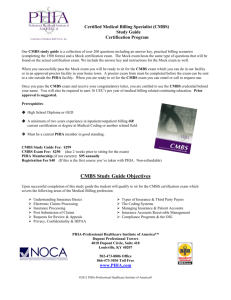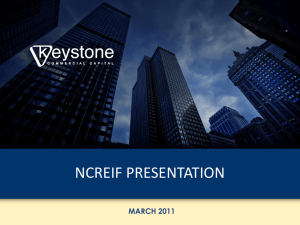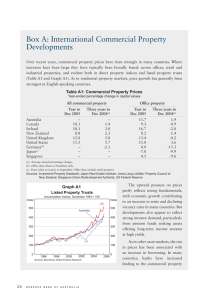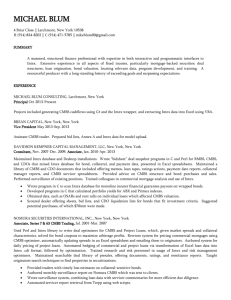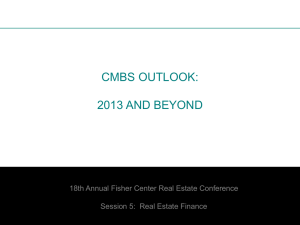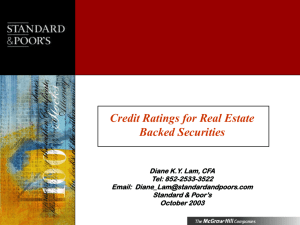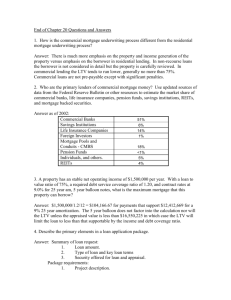The Premature Pricing of Commercial Real Estate Distress
advertisement
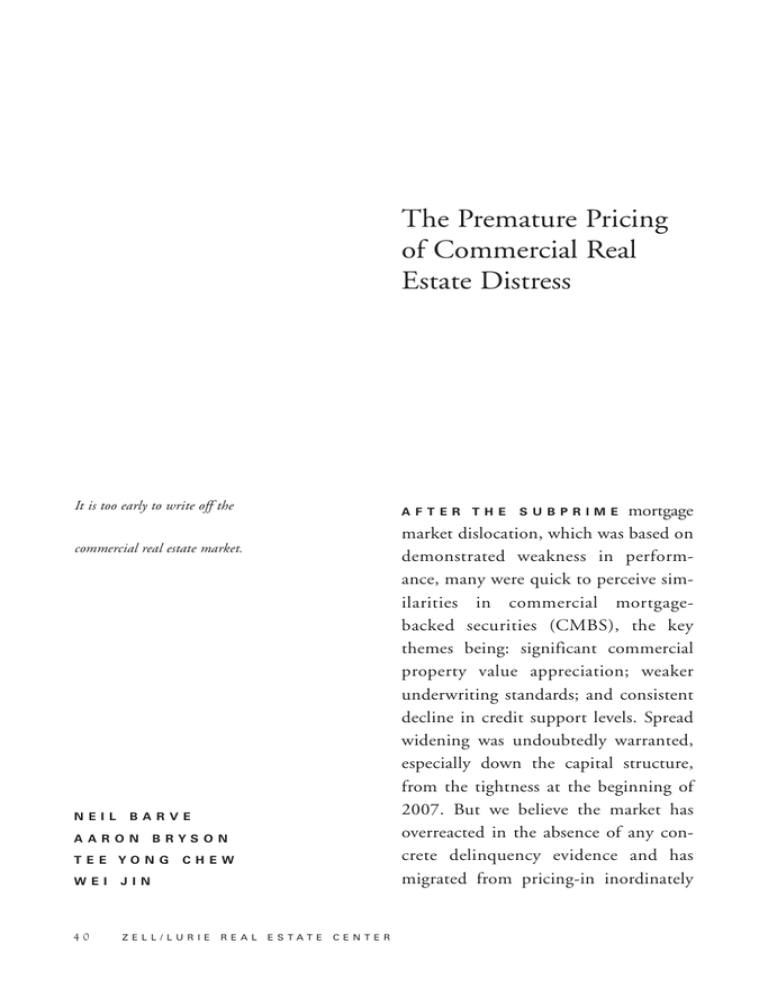
The Premature Pricing of Commercial Real Estate Distress It is too early to write off the A F T E R T H E S U B P R I M E mortgage market dislocation, which was based on demonstrated weakness in performance, many were quick to perceive similarities in commercial mortgagebacked securities (CMBS), the key themes being: significant commercial property value appreciation; weaker underwriting standards; and consistent decline in credit support levels. Spread widening was undoubtedly warranted, especially down the capital structure, from the tightness at the beginning of 2007. But we believe the market has overreacted in the absence of any concrete delinquency evidence and has migrated from pricing-in inordinately commercial real estate market. NEIL BARVE AARON BRYSON TEE YONG CHEW WEI JIN 40 ZELL/LURIE REAL ESTATE CENTER low collateral losses to pricing-in inordinately high collateral losses. To estimate spread-implied bond losses, there are two moving parts: the magnitude of loss, and the timing of loss. In our November 8 paper, “CMBX Valuation: Version 2.0 of Loss Dispersion Approach,” we detailed our approach to estimating spread-implied losses. The results for CMBX.4 are shown in Table I. Note that although we use the CMBX contract to demonstrate loss scenarios, the results are relevant for the cash market as well. For example, a buyer of protection on the AA class at a spread of 258 bp will lose on the trade only if the underlying portfolio of securities takes more than a 27 percent write-down, and the average timing of this write-down is 7.7 years. We estimate that the overall average collateral loss level would have to rise to 9.3 percent for the AA portfolio to take 27 percent writedowns, considering AA credit support and tranche size, as well as the likely dispersion of losses across deals. Comparing these market-implied losses across tranche ratings, as well as against historical benchmarks, provides two observations. First, high collateral loss levels are already priced in; spreads across ratings are already pricing in a multiple of the 2.2 percent average cumulative loss for the 1995 to 1999 CMBS vintages. Second, relatively higher collateral losses are priced into the higher rated classes. For example, we estimate that buyers of CMBX.4.A protection would need average collateral losses to rise to 7.7 percent to break even; but the Table I: Using CMBX.4 to quantify what’s priced into spreads AAA AJ AA A BBB BBB- Average bond characteristics: Credit support 12.3% 10.2% 7.8% 4.4% 3.4% Tranche size 7.6% 1.4% 1.0% 1.1% 1.1% Current spread 158 bp 258 bp 367 bp 800 bp 1006 bp 18% 27% 35% 64% 74% Assumed average loss timing 8.9 yr. 7.7 yr. 6.5 yr. 6.0 yr. Average deal loss 11.8% 9.3% 7.7% 7.0% Market implied losses: Average bond loss Average deal loss, historical context: 6.5% Context '95-99 CMBS vintage average 2.2% 1986 vintage (est. worst pre-CMBS cohort) 8.1% Source: Lehman Brothers, Markit Partners Table revised on December 13, 2007. REVIEW 41 threshold is only 6.5 percent for buyers of lesser CMBX.4.BBB- protection. In fact, the 1986 (pre-CMBS) cohort of commercial mortgages is estimated to have taken an 8.1 percent cumulative loss in the turbulent (and minimal equity) environment of the late 1980s and early 1990s. Yet losses greater than that level are priced into classes rated single-A and higher. Even considering the clouds on the horizon, we think it’s premature to price in such high levels of distress. S O W H AT DOES IT MEAN? Since markets are pricing in commercial mortgage losses comparable with the late 1980s/early 1990s, we take a closer look at this difficult period for commercial real estate. According to NCREIF, property values dropped an average 32 percent across property types from December 1989 to December 1995. According to PPR, average nominal rent levels in the office sector dropped 12 percent from the second quarter of 1991 to the second quarter of 1993, while office vacancies peaked at just under 19 percent. And according to the FDIC, the total cost to taxpayers and thrift institutions of the fallout was over $150 billion—more than 3 percent of nominal GDP. The commercial real estate recession of the early 1990s had its origin in an unprecedented 1980s boom in new con- Figure 1: Growth in commercial mortgage stock 25% 20% 15% 10% 5% 0% -5% -10% 83 85 87 89 91 93 Commercial/MF Mtg Stock as % of GDP 42 ZELL/LURIE REAL ESTATE CENTER 95 97 99 01 03 05 07 YOY % Chg in Commercial/MF Mtg Stock Figure 2: Driven by conduit programs 100% 80% 60% 40% 20% 0% 81 83 Other 85 87 89 Savings Inst 91 93 95 Insurance Cos struction activity, fuelled by tax beaks and a surge in lending activity. Several factors led to excessive lending, including the phasing out of a ceiling on deposit rates, which led to an increase in risk appetite by thrift institutions chasing higher returns, and changes to the tax code that made it more advantageous for investors to own commercial real estate. The new supply of space far exceeded the pace of absorption, resulting in a dramatic increase in vacancies. The surge in lending in recent years is somewhat comparable with that in the early 1980s. In the third quarter of 2007, the outstanding commercial mortgage stock, including multifamily, reached 23 97 99 ABS Issuers 01 03 05 07 Commcl Banks percent of GDP; the last time it was over 20 percent was in 1988 (Figure 1). The recent growth in commercial mortgages has been driven by conduit lending programs, denoted by “ABS Issuers” in Figure 2, which have aggressively expanded their market. However, we think that there are material differences this time, which will prevent losses from reaching the high levels of twenty years ago. First, we do not see remotely the same magnitude of new supply. Net completions as a percentage of stock have been running at much lower levels across the major property types relative to the mid-1980s (Figure 3). A key reason that supply has remained in check REVIEW 43 Figure 3: Supply comparison 10% 9% 8% 7% 6% 5% 4% 3% 2% 1% 0% 82 84 86 88 90 WH, ttm 92 94 96 98 OFF, ttm 00 02 04 RET, ttm 06 APT, ttm Source: PPR Figure 4: Rising construction costs 180 160 Index 140 120 100 80 60 80 82 84 86 88 90 92 94 96 98 00 02 04 06 CRB Index Raw Materials Index Source: Lehman Brothers is the surge in construction costs (Figure 4), which has kept new construction in check and contributed to significant value appreciation in recent years. 44 ZELL/LURIE REAL ESTATE CENTER Relatively low vacancy rates and strong rental growth exist today across major property types (Table II). In key supply-constrained office markets such Table II: Comparison of commercial real estate fundamentals National Averages Warehouse Retail Office Apartment 3Q07 vacancy rate 8.6% 10.4% 14.7% 5.8% Average vacancy rate (1990-2007) 8.9% 13.8% 15.0% 5.2% TTM rent growth 3.5% 3.0% 8.3% 5.4% Average rent growth (1991-2007) 1.2% 0.7% 1.6% 2.4% Source: PPR as New York City, which are over-represented in CMBS pools, the trailing twelve-month rent growth average is a staggering 22 percent, according to PPR. Even if office rent growth stagnates or comes under modest pressure, we would expect net cash flow generated by properties to trend upward given the staggered nature of office lease terms. The same principle should apply, albeit to a lesser extent, in many other markets. However, investors must be wary about loans in which some (or all) of this upward NOI momentum was factored into underwriting. Another key difference between today and the earlier meltdown is the speed and transparency with which the repricing of risk has occurred. The growth of derivative products, such as CMBX, has expedited the repricing of risk, even before meaningful increase in delinquencies/losses. Although we believe the repricing is overdone in higher-rated classes, if aggressive loan underwriting had persisted, the eventual credit fallout could have been far worse. In contrast, in the 1980s, bad loans were buried on bank balance sheets for the better part of the decade. Over the past decade, commercial real estate has also become a more mainstream asset class, with a deeper investor base. Foreign investors are active buyers of properties, especially in Tier 1 markets. According to Real Capital Analytics, acquisitions of core assets (office, industrial, apartment, and retail) by foreign buyers amounted to $32 billion in the first three quarters of 2007, compared with only $10 billion in all of 2003 (see Figures 5 and 6 for breakdown). Although we think cap rates are in the process of rising, the greater depth of the investor base should make market corrections less violent than in the past. Granted, the 2006 and 2007 vintages are likely to experience higher average collateral losses over their life than the 2.2 percent average of the 1995 to 1999 vintages. However, we do not think there is justification to price in losses in excess of those experienced during an especially distressed period for commercial real estate. It is possible that the 2007 mortgage vintage REVIEW 45 Figure 5: Foreign property acquisitions, by type 35 30 25 $ bn. 20 15 10 5 0 2001 2002 2003 2004 Apartment Retail 2005 Industrial 2006 2007 Office Source: Real Capital Analytics Figure 6: Foreign property acquisitions, by country 35 30 25 $ bn. 20 15 10 5 0 2001 2002 2003 2004 2005 Offshore–Other Pacific Rim United Kingdom Europe Canada MidEast 2006 2007 ermany Australia Source: Real Capital Analytics will, over the next decade, prove to be the worst performing vintage in the history of commercial real estate. But that would be 46 ZELL/LURIE REAL ESTATE CENTER an extreme outcome, not the base case. A trade that breaks even only when such a tail event materializes, losing otherwise, does not represent a good risk/reward trade-off. Our base case average cumulative deal loss projection is 4.25 percent for recently issued transactions. IT’S NOT SUBPRIME A key reason for the market to price high levels of losses over such a quick span of time is simplistic comparisons with subprime. While there are some common themes, insufficient attention is paid to some fundamental differences. First, commercial real estate fundamentals are generally solid, with pockets of weakness. As a result, CMBS delinquency levels remain low. A comparison of the 60+-day delinquency rate for the 2006 vintage tells the story: 22 percent for subprime versus just 0.18 percent for CMBS. Second, borrower profiles are very different. The borrowers of CMBS are often well-capitalized commercial real estate operators, sometimes publicly traded REITs. Yes, they took advantage of the easy availability of leverage, and may have been over-optimistic about future cash streams from properties. But they are far more sophisticated—and much better capitalized—than subprime borrowers. Also, near-term mortgage “reset” pressures are relatively low for CMBS. We do not see the same trigger mechanism creating a wave of defaults as exists in the sub- prime sector via interest rate resets. The majority of CMBS loans are ten-year average life and fixed rate. The “reset” equivalent is “partial interest only” (IO) loans (40 percent of 2006 vintage), which will see an increase in their debt service burden as they transition from IO to amortizing. Although this warrants attention, we do not believe this is nearly as important as the resets on the subprime side. If the incremental principal portion of the debt service tips borrowers into default, granting continued IO status is a relatively easy and low-cost loan modification. Loan modifications are a routine occurrence in CMBS, used by special servicers to maximize trust proceeds. Further, the home-price appreciation (HPA) equivalent is not the primary default driver. HPA is a key default driver in subprime. In the case of income-generating commercial properties, a decline in property valuations stemming from an adverse change in the debt market, or from a scaling back of income growth projections, is not sufficient to trigger a surge in defaults. So long as the net income generated by the property covers debt service, there is little incentive for borrowers to default. Hence, rent growth, which is a function of the demand-supply landscape for space, is the key. Given that new supply of space is generally in check, significant negative net absorption is necessary to cause a major spike in defaults. Even then, REVIEW 47 we may not see losses to the tune of what is priced into spreads. And there are no “no docs” CMBS loans. The degree of deterioration in CMBS underwriting standards must be put into perspective. An estimated 40 percent to 45 percent of 2005 and 2006 subprime issuance were loans with “no documentation” or “limited documentation,” for which the borrower’s stated income was accepted with little or no validation. On the CMBS side, one can call into question the income upside assumptions that are underwritten into many loans, but the accuracy of the rent roll and property financial information is generally not an issue. Larger CMBS loans usually come with audited financial statements, and there is normally sufficient loan-level attention paid even to smaller loans to minimize instances of misrepresentation by the borrower. Having a couple of hundred—as opposed to thousands—of loans in each CMBS pool helps. Finally, let’s not forget the role of the B-piece buyer. The below-investmentgrade stack in a CMBS transaction is the domain of B-piece buyers, a group of investors with significant commercial real estate expertise. They are the first to lose when there are defaults in a pool. More often than not, the CMBS B-piece buyer is also the special servicer in the transaction, mandated to work out delinquent loans and maximize proceeds to the trust. 48 ZELL/LURIE REAL ESTATE CENTER This natural alignment of interests and the ability of B-piece buyers to kick out loans that they are uncomfortable with served as an important benefit to the investors in the more senior securities. Admittedly, this benefit diminished over time as B-piece buyers increasingly issued CDOs backed by their B-pieces (diluting the alignment of interest) and strong competition reduced the incidence of loan kick-outs. Now, with the CDO market stalled, the relevance of the B-piece buyers as an instrument of loss mitigation has increased. THE CLASS OF 20 07 We now take a look at 2007, focusing on issuance, spread and return performance, and credit performance. The year 2007 was challenging for CMBS market participants. The credit flare that began in February, ignited by the subprime mortgage market, erupted into a full-blown credit wildfire in the summer and into November. There were sharp corrections in CMBS debt market pricing and availability. However, underlying sector fundamentals largely remain firm as we enter 2008, though with some areas of concern. Despite a sharp slowdown in the second half of 2007, annual issuance was just under $230 billion (Figure 7), making 2007 look like a record year for 45 250 40 225 35 200 175 30 150 25 125 20 100 15 75 10 50 5 25 0 Jan Feb Mar Floating Apr May Jun Fixed Jul Aug Sep Oct Nov Cumulative Issuance ($, bln.) Monthly Issuance ($, bln.) Figure 7: 2007 CMBS domestic supply: A tale of two halves Dec Cumulative, rhs Source: Lehman Brothers. December issuance is estimated based on data from Commercial Real Estate Direct. CMBS issuance. First-half issuance occurred at a blistering pace, with domestic supply totalling more than $139 billion. Private equity funds repeatedly tapped CMBS to finance leveraged acquisitions. February marked a high-water mark, when Blackstone purchased Equity Office Properties Trust (EOP), an office REIT, for $39 billion. Second-quarter issuance dropped noticeably, particularly in the fourth quarter, reflecting the credit crisis and uncertainty about CMBS pricing. We estimate that second-half-2007 domestic issuance was $90 billion, down 35 percent from the first half. The floating-rate CMBS market was hit hard by the credit market rout, as traditional buyers such as European banks and structured investment vehicles dramatically pulled back. Meanwhile, the quality of issuance deteriorated until some signs of improvement emerged in the fourth quarter (Table III). According to S&P, average debt service coverage ratios bottomed out at 1.25x in the second quarter, before rebounding slightly in the fourth quarter. The rating agencies began to push back against weaker underwriting trends in the second quarter, and credit subordination levels were raised. However, high volumes of loans made prior to that continued to be worked off through the balance of the year. Both prepayment and defeasance activity declined through 2007, reflecting the downward pressure on property values and tightening credit terms. Trailing four-quarter average defeasance activity as of third-quarter-2007 data was REVIEW 49 Table III: Initial signs of improving collateral trends in 4Q S&P rated deals 1Q07 2Q07 3Q07 S&P NCF adjustment -7% -10% -8% -8% S&P DSCR 1.38 1.25 1.27 1.30 U/W DSCR S&P Beg. LTV 4Q07 1.47 1.45 1.39 1.39 109% 117% 114% 107% U/W LTV 68% 70% 66% 67% Percent shadow rated IG 14% 5% 5% 8% Top 10 percent 42% 37% 43% 45% Percent full IO 56% 62% 56% 47% Percent partial IO 29% 25% 33% 40% BBB- credit support 2.8% 3.1% 3.5% 3.5% 9 13 16 9 # of deals Source: Lehman Brothers, S&P $190 million, down from more than $800 million in the fourth quarter of 2005 (Figure 8). To gauge prepayment activity, we look at trailing twelve-month CPRs for loans in their yield maintenance period that have also started trend- ing lower (Figure 9). Defeasance and prepayments have been important drivers of rating upgrades in recent years. The slowdown in such activity, which we expect to persist, will reduce the pace of subordination build-up in pools. Figure 8: Drop in defeasance activity 1,200 1,000 800 600 400 200 0 99 00 01 02 03 Quarterly Defeasance Volume ($mm) Source: Lehman Brothers 50 ZELL/LURIE REAL ESTATE CENTER 04 05 06 Trailing 4 Qtr Avg ($ mm) 07 Figure 9: Drop in prepayment activity 25% 20% 15% 10% 5% 0% 99 00 01 02 03 04 05 06 07 Trailing Twelve Month Yield Maintenance CPR Source: Lehman Brothers Figure 10: Dramatic credit curve steepening 1,000 900 800 Spread (bp) 700 600 500 400 300 200 100 0 AAA SD AAA AJ 12/30/05 AA A 12/29/06 BBB 11/30/07 BBB- Source: Lehman Brothers The prolonged period of CMBS spread compression came to a dramatic end in 2007, especially down the capital structure. Generic BBB cash spreads widened by more than 600 bp, to S+800 bp, as the credit curve steepened (Figure 10). Senior AAAs outperformed on a relative basis, but failed to provide a safe REVIEW 51 Figure 11: CMBS lags core fixed income sectors 0 -92 -222 -192 -500 -533 -546 -570 -1,000 -1,500 -2,000 -2,500 -3,000 -2437 US Agg Agcy MBS Corp CMBS Fixed Rate YTD 11/30/07 XS Returns vs Treasury ABS BBB CMBS Source: Lehman Brothers haven amid credit market turmoil. Tenyear 30 percent credit support AAA CMBS widened to more than S+100 bp in November, eclipsing the prior historical wide level reached in October 1998. Compared with other core fixed income sectors, the CMBS Eligible for U.S. Aggregate Index, which is 97 percent AAA-rated, was a noticeable laggard, delivering -546 bp of excess returns yearto-date, and a high ex-post tracking error (Figure 11). Synthetic markets, particularly CMBX, played an important part in the repricing of CMBS credit risk. In the major spreadwidening moves in February, July/August, and November, CMBX spreads led cash market spreads wider. Index trading volume picked up dramatically, and a host of new investors entered the market to express neg- 52 ZELL/LURIE REAL ESTATE CENTER ative views on commercial real estate. Tiering activity between different series reflected the market’s perception of progressively weaker collateral. Despite the significant repricing of debt and the deepening single-family housing recession, underlying commercial real estate sector fundamentals remained largely steady. Vacancy/availability rates held firm across the major property types, with the exception of retail (Figure 12). Rent growth was strong, especially in supplyconstrained markets. However, the credit market correction led to reduced availability and a higher cost of debt for borrowers. This has begun to filter into higher cap rates. The Moody’s CPPI Commercial Real Estate Index, which uses a repeat-sales methodology, posted a 1.2 percent decline in nationwide average property prices in Figure 12: CRE fundamentals steady 16% 15.0% 14.7% 14% 12% Vacancy 10.4% 9.8% 10% 8.6% 8.6% 8% 5.8% 6% 5.8% 4% 2% 0% Office Retail Apartment 2006Q4 Warehouse 2007Q3 Source: Lehman Brothers Figure 13: CMBS credit indicator improves 1.00% 8% 0.75% 7% Credit Indicator 0.50% 6% 0.25% 5% 0.00% 4% -0.25% 3% -0.50% 2% -0.75% 1% -1.00% -1.25% 99 00 Total 01 Retail 02 03 Office 04 05 Multifamily 06 07 Hotel (RHS) 0% Source: Lehman Brothers September, although it is still up 8.5 percent year-over-year. But the true decline in property values was likely masked by a drop in transaction activity. Strong fundamentals led to improved overall CMBS credit performance. However, there were pockets of weakness in recent vintages. The overall CMBS 60+- REVIEW 53 day delinquency rate declined 6 bp yearto-date, to 0.33 percent. This was better than seasoning-implied expectations, leading to an improvement in our credit indicator metric (Figure 13). Across more recent vintages, there was a slight uptick. 2006 vintage delinquencies ticked up to 0.18 percent, led by the multifamily sector. W H AT NEXT? Commercial real estate fundamentals are set to weaken, which will end the heady property value appreciation/NOI growth of recent years. This will put upward pressure on delinquencies and losses in 2008, albeit from a low starting point. However, those looking for deterioration in credit performance similar to that on the residential mortgage side are likely to be disappointed. We expect the decline in property values to continue, given the repricing of debt and the effect of decelerating economic growth on rent projections. We highlighted our initial reaction to the debt market repricing in an earlier paper, “CMBS Market Correction and Commercial Property Valuations.” Since September 2007, credit market turmoil has intensified, putting upward pressure on cap rate spreads (spread differential between cap rates and Treasury rates). But the rally in longer-term interest rates has cushioned the blow. If we focus just on the debt market repricing and the subsequent effect on cap rates, we find that only a low singledigit correction in property values from mid-2007 levels is warranted (Table IV). Recent economic data point to downside risks to previous rent growth assumptions. If rental growth projections are scaled back by 50 percent, which we think could happen even in the absence of a severe economic downturn, a roughly 10 percent to 20 percent average drop in property values from mid-2007 levels Table IV: Different scenarios for change in property values since 1H07 REPRICING SCENARIO “Generic” property Cap Rate Prop. Val Chg. Chg. Debt market repricing only “Premium” property Cap Rate Prop. Val Chg. Chg. +25 bp -3.8% +18 bp -4.2% +62 bp -8.8% +50 bp -18.7% +100 bp -13.6% +179 bp -31.0% Debt market repricing & 50 percent rent growth haircut Debt market repricing and 100 percent rent growth haircut Source: Lehman Brothers, S&P 54 ZELL/LURIE REAL ESTATE CENTER occurs, depending on the property. A strong influx of foreign capital could serve as a mitigating factor, especially for properties in top-tier markets. We do not expect even such a decline in property values to lead to a surge in delinquencies and defaults, as actual NOI growth is the key to credit performance, although a noticeable uptick in delinquencies is to be expected, given aggressive underwriting trends in recent vintages and potential economic weakness. We believe that recent vintage “pro forma” loans, which embed some degree of upside at origination, are most at risk. The weighted average 2005 to 2007 vintage 60+-day delinquency rate is only 0.25 percent currently. If delinquencies follow historical seasoning patterns, the 2005 to 2007 vintage average 60+-day delinquency rate should increase to 0.67 percent by the end of 2008. But given weaker underwriting in recent vintages and the potential for a slowing economy, we expect delinquencies to ramp up faster than historical seasoning patterns. We use 1998 to 2000 vintage performance in 2001 as a guide for potential credit performance in a weak economy. The United States entered a mild recession in 2001. Over this period, 1998 to 2000 vintage CMBS credit performance was weaker than typical seasoning implied expectations would suggest (Figure 14). If we scale up this relative underperformance by an additional 50 percent to account for weaker underwriting trends in recent vintages, 60+-day delinquencies across 2005 to 2007 vintages would only increase to 0.95 percent through 2008. This provides a reasonable base-case. We estimate that the average size of IO resets is 15 percent to 25 percent, and the typical IO term is two to three years. Figure 14: A look at recent vintage CMBS credit performance in 2001 Change in 60+ day delq, 2001 0.8% 0.7% 0.6% 0.19% 0.31% 0.5% 0.4% 0.3% 0.52% 0.2% 0.28% 0.35% 0.1% 0.11% 0.0% 1998 1999 Excess over seasoning implied 2000 Seasoning Implied Source: Lehman Brothers REVIEW 55 Figure 15: Partial IO to fully amortizing loans by vintage/date of “reset” 40 35 $, billion 30 25 20 15 10 5 0 2008 2009 2010 2011 Date of "reset" 05 vintage 06 vintage 2012 2013 07 vintage Source: Lehman Brothers Across 2005 to 2007 vintage CMBS collateral, some $33.6 billion of partial IO loans are set to move to amortizing status in 2008 (Figure 15). Of this amount, $2.5 billion (7 percent) have an amortizing DSCR of less than 1.1x, indicating some pressure on post-reset payments and upside risk to default expectations. But as explained earlier, if the increase in debt service is pushing borrowers past the tipping point, loan modification should be easy adjustment for the special servicer. Hence, we are not concerned about such loans. Additional positive factors should prevent an alarming increase in near-term delinquencies: funded reserves of more than a year for many of the “pro forma” 56 ZELL/LURIE REAL ESTATE CENTER loans with DSCR less than 1.0x; and positive mark-to-market rent momentum on leases expiring even if market rents trend down. The latter highlights the long-term nature of tenant leases, particularly in the office and retail sectors. SL Green, a major office REIT that has tapped fixed-rate CMBS financing for its Manhattan office portfolio, pointed to re-leasing rental increases of 40 percent to 50 percent across its Manhattan properties. Given the magnitude of losses reflected by current market spreads, we suspect that many who expressed short views up the capital structure through CMBX will be disappointed by the realized increase in delinquencies through 2008. We do not envision a rise remotely comparable with what we’ve witnessed on the subprime side. Hence, the resilience of the buyers of protection at recent wide levels will likely be tested. We are most concerned about the multifamily and retail sectors, which are vulnerable to a consumer-led economic slowdown. In multifamily, the concern is market-specific, as we have a negative view of markets that are heavily exposed to condo “reversion” exerting downward pressure on rents. Such condo markets include most of Florida, Las Vegas, Phoenix, and Southern California. Retail weakness is likely to be more widespread. We believe MSAs that experienced the fastest growth in single-family home price appreciation during the “bubble” period are likely to be most affected, given the negative wealth effects on consumer spending. In addition, there is downside risk to the hotel sector, especially for limited service, if we enter a recession, given the “overnight” nature of the leases. We remain neutral on the office sector, but are negative on office markets with heavy exposure to mortgage finance-related employment, such as Orange County. Issuance in 2008 will slow sharply from record 2007 levels. Loan origination has dried up, as dealers are less willing to lend given debt market turbulence, and borrowers balk at stricter underwriting guidelines. REIT privatiza- tion activity has slowed, and we do not expect a material rebound. We expect this stand-off to persist for the early part of 2008 before stabilizing late in the year, absent an economic recession. However, the more than $30 billion in conduit loans due for refinancing in 2008, adjusted for defeasance, should provide some degree of baseline demand, especially considering the significant appreciation that the underlying properties have enjoyed over the years. Our base-case 2008 supply projection is $110 billion, a 50 percent drop from 2007 levels. We caution that the accuracy of our 2008 supply projection is highly correlated with the accuracy of our 2008 AAA CMBS spread forecast. In particular, the floating-rate market is a wild card. If the floating-rate market stabilizes, we could see 2008 CMBS supply exceed our projections, given the large volume of collateral held by investment banks. WHERE I S T H E VA L U E ? CMBS performance, along with that of all non-agency securitized products, was abysmal in 2007. Heading into 2008, we are likely to see more negative headlines about commercial real estate and continued comparisons with the housing sector. Downside risks to the economy are significant, and a near-term recession would REVIEW 57 have an especially adverse effect on the performance of recent vintage “pro forma” collateral. However, for those who are able to filter through the noise (and spread volatility), there is compelling relative value in higher-rated CMBS, where spreads reflect levels of distress beyond that seen in the commercial real estate recession of the late 1980s. We continue to have opposing views for the high end and the low end of the CMBS investment-grade capital structure, despite a sharp steepening of the credit curve in 2007. We maintain our overweight recommendation to AAAs down to single-As, for which we believe market spreads embed excessive collateral loss expectations relative to underlying fundamentals. However, we maintain an underweight to recent vintage BBB/ BBB-classes given the potential for further downside in a negative economic environment and weak technicals. We also see compelling value in AAA CMBS relative to other fixed income sectors, particularly high-grade corporates. The 30 percent credit support cushion of “super-duper” AAAs implies that more than 85 percent of a pool can default with 35 percent loss severity before the super-duper starts taking losses. Even if loss severities rise from the historical average of 35 percent to, say, 50 percent, as much as 60 percent of the pool by balance can default without 58 ZELL/LURIE REAL ESTATE CENTER causing losses to dupers. As mentioned earlier, the infamous 1986 vintage (before the CMBS market was born) had only an 8.1 percent cumulative loss through the commercial real estate crisis of the late 1980s and early 1990s. The credit support of a super-duper covers this four times over. We believe that dupers have negligible risk of loss and that current spread levels are largely a result of the overall liquidity crunch instead of concerns about credit losses. Ten-year 30 percent credit support AAAs are the most liquid CMBS securities, and should lead any broad-based rally. Our expectation of a 50 percent drop in 2008 issuance volume should serve as a positive technical factor. However, high spread volatility in recent periods argues for a more active AAA basis call than in the past. Our initial spread target is 50 to 60 bp for recent vintage generic senior AAAs, versus current levels of S+94 bp. Assuming that underwriting standards continue to improve and credit support levels don’t fall commensurately, we will see better quality securities issued in 2008 compared with similarly rated securities from 2006 and 2007. This could lead to significant vintage-based tiering, with the “on-the-run” newly issued securities trading tighter than the 2006 and 2007 vintages across the capital structure. Table V: AAA CMBS comparables 12/29/06 spread to LIBOR (bp) 12/11/07 spread to LIBOR (bp) 10-year AAA Sr. CMBS 23 94 Prime non-agency AAA RMBS 42 185 3-year AAA credit cards 34 152 AAA CLOs 25 61 Source: Lehman Brothers While AAA CMBS spreads are attractive in isolation, one can argue that other high-quality securitized asset classes also offer compelling value: AAA CLOs, prime non-agency AAA RMBS, and AAA credit cards, for example (Table V). We believe that it will be difficult for AAA CMBS to stage a meaningful rally in the absence of a recovery and improved liquidity across these competing high quality securitized assets. Across mezzanine classes, we see value down to the single-A level, as spreads are sufficient to compensate for most base-case loss expectations. We do expect select AAs and As to take losses over the ensuing ten years, and given the degree of leverage embedded in these securities, losses on any given security are likely to be significant. However, current spread levels adequately compensate for this risk. Figure 16 shows the “loss-adjusted yield” for portfolios of generic-rating classes of mid-2007 vintage cash bonds relative to the ten-year swap rate. AA and A-rated securities offer positive “loss-adjusted” returns over swaps until average deal Figure 16: “Loss adjusted yield” for portfolios of different ratings across average deal loss scenarios "Loss-Adjusted" Yield 15% 10% 5% 0% -5% -10% -15% -20% 2.0 Base Case Average Projected Deal Loss, mid 2007 vintage collateral 3.0 AJ 4.0 AA 2X Base Case Average Projected Deal Loss, mid 2007 vintage collateral 5.0 6.0 7.0 Average Deal Loss (%) A BBB 8.0 BBB- 9.0 10.0 10-yr swap rate Source: Lehman Brothers REVIEW 59 loss reaches around 9 percent and 7.5 percent, respectively. Despite the credit curve steepening, we see an asymmetric risk/reward profile down the capital structure. The downside for BBB/BBB- securities is substantial. As average deal losses cross only the 5 percent to 6 percent range, these classes deliver increasingly negative returns relative to swaps (Figure 16). We foresee greater uncertainty in lower-rated classes with respect to the actual timing of loss. Finally, there remains a weak technical environment for such securities, mainly a diminished buyer base given the drop in CDO manager participation. We expect to see a better credit profile in BBB/BBB- securities issued in 2008 as collateral quality improves, so long as credit support levels do not decline. AAA CMBS offers compelling relative value versus core fixed income asset classes, especially given its relatively weak performance in 2007. We prefer to own AAA CMBS versus high-grade corporates. Generic ten-year AA-rated corporate sector spreads to swaps are at 75 to 80 bp, versus 94 bp for AAA CMBS. We do not see the same type of distress priced into corporate sector spreads as we do in CMBS. We see CMBS value versus both agency debentures and agency-backed MBS. Senior AAA CMBS spreads are Figure 17: AAA CMBS versus Agency MBS, AA Corporates 40 +26 bp over AA Corporates +20 bp over FNCL CC ZV spread 30 20 Bp 10 0 -10 -20 -30 -40 -50 97 98 99 00 01 AAA CMBS - AA Corp Basis Source: Lehman Brothers 60 ZELL/LURIE REAL ESTATE CENTER 02 03 04 05 06 AAA CMBS - MBS ZV Basis 07 Trailing 36 mo tracking error, bp in monthly terms Figure 18: Ex-post tracking error (relative to Treasuries) 70 66 64 60 54 50 40 29 30 29 24 20 17 15 10 10 10 0 Agcy ABS CMBS Dec-06 Nov-07 MBS Fixed Rate Corps Source: Lehman Brothers near historical highs relative to currentcoupon mortgage passthroughs (Figure 17). However, traditional investors will likely keep in mind the recent surge in spread volatility in AAA CMBS. Prior to 2007, the CMBS component of the U.S. Aggregate Index, which is 97 percent AAA-rated, exhibited spread volatility similar to that of the more mature agency debenture and pass-through markets. In 2007, CMBS decoupled from the agency and MBS sectors—in terms of both spread widening and volatility (Figure 18). We suspect that investors will require a higher “risk premium” for investing in AAA CMBS than they required in the past, which should keep spreads from reverting to early 2007 lev- els even if credit conditions improve. This should keep the “basis” between AAA CMBS and the agency debenture and pass-through sectors wider than fundamentals would suggest, but significantly tighter than current levels. CONCLUSION The overriding theme as we enter 2008 is the premature pricing-in of CMBS distress, particularly up the capital structure. Spreads on higher-rated CMBS classes (AAA through A) reflect loss expectations comparable with or beyond those seen in the commercial real estate recession in the late 1980s/early 1990s. REVIEW 61 Despite downside risks to recent vintage collateral from a weakening economy, we find it premature to price in such a level of base-case losses. Underlying commercial real estate fundamentals remain firm and comparisons with subprime are overstated. We see compelling relative value in higher-rated CMBS (AAAs through A), for which spreads reflect excessive collateral loss expectations. However, we expect that it will be difficult to stage a material rally in the absence of improved liquidity in other competing high-quality securitized assets. We remain underweight lower-rated classes (BBB/BBB-) given the potential for still further downside. A version of this article was previously distributed to clients of Lehman Brothers. No part of this document may be reproduced in any manner without the written permission of Lehman Brothers. ©2008 Lehman Brothers. All rights reserved. 62 ZELL/LURIE REAL ESTATE CENTER
